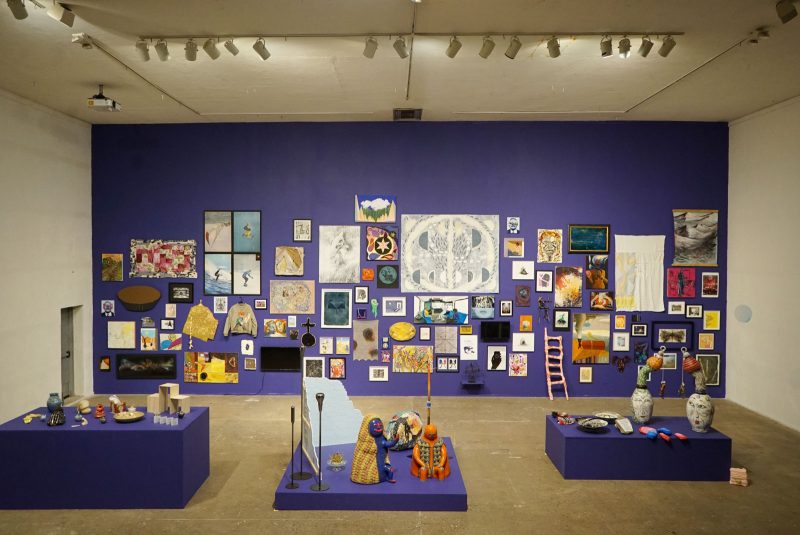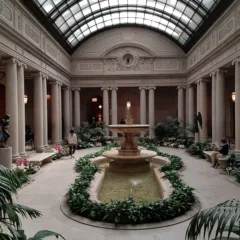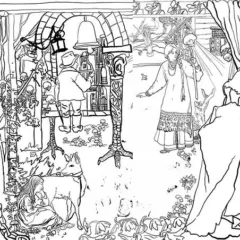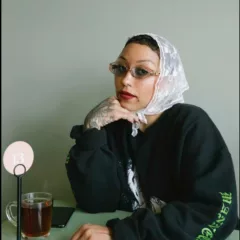
When a planned exhibition at Icebox Project Space fell through, co-curators Logan Cryer and Tim Belknap decided that, instead of leaving the gallery empty, they’d have an open call– in the truest meaning of the term. After accepting all artwork that was dropped off between June 9-12th, the show, Now, One With Everyone! , features over 100 works of art. We encourage you to attend the closing reception this Friday, June 24th, and see the show before it closes this Sunday, June 26th!
Roberta Fallon: I really adore this show. In your press release, you say it’s the only show of its kind that’s been in the Icebox. And that sounds right to me, but there have been other shows that I – in my mind’s eye and memory – have called a Philadelphia Biennial. You know what I’m talking about, Tim?
They weren’t open call, so that might be the only difference– but they were curated and they were really diverse. So there is some precedent for this type of, “let’s get more people here, and let’s show more people, and let’s include more people, and put on a really good show.”
Tim Belknap: Yeah. And we talk about those shows often, Unlisted, and then Begin Where you Are.
[ED. Note: See an Artblog review of ‘Begin Where you Are’ here.]
Live/ Work was something similar. Live/ Work was the show that Ryan and I curated, it was actually right before Unlisted. With Unlisted, we were really focusing on curators. And then the curators brought in the artists. So it was very hands off in terms of who was showing, but it was like, who were the organizers?
Live/ Work was a show that Ryan and I did before that, and we really wanted to think about the artist that’s out of school and trying to just live and work. So it was like an age range [thing].
Logan Cryer: It was 26 and under.
Tim: Yeah. And it was curated. So we did reject certain works, but that one was pretty open. I mean, looking at that age range too, what can you make? You know, if you don’t have the studio and you’re working out of your apartment?
We talk about those shows because we have something in the works that is very much in vain of Unlisted.
Logan: Oh yeah. A sequel if you will, that– grant allowing– will happen in 2023.
So for 2023, we have a show idea which is called Invited: take care of the square footage. It’s similar to Unlisted in that we would be inviting curators. But the difference is that we would programmatically be focusing on teaching people how to curate.
So, starting from exhibition build out, like as we’re building an exhibition, having a workshop on here’s how you assemble drywall, and here’s how you hang work, and then going into: here’s how you set up audio, here’s how you work monitors, and projectors, here’s how you write a grant proposal…Here’s how you budget, and just kind of go through that whole thing.
Tim: Yeah. And, and unlike Unlisted, I mean, where a lot of the curators were really established curators: Nato Thompson, you had Sid Sachs, you had Judith Tannenbaum, people that have been doing it their whole life.
This would still be curators who are actively curating, but much younger.
Logan: Yeah, but younger, and more focused on, what does curating look like as an independent curator, outside of a museum context?
Tim: Yeah. In alternative spaces, and thinking about some of the architecture, would it be very more unstructured in a way that Unlisted was, where it was very gridded out and divided and everybody got a certain amount of [space].
Logan: Right. Everyone gets the same space, but this might be a little bit more like… Different types of space setups.
It’s such a big space. The only reason why we don’t do shows like this more often is it’s so expensive. I mean, 1. the cost of lumber has gone up incredibly. But even before that, just the amount of lumber it takes to build something is intense. And that’s not counting in labor or anything else like that.
So what was interesting about this show [Now, One with Everyone!] is we didn’t do a build out, so much as we just bought a lot of paint.
Roberta: Indigo paint! Tell me why indigo. I love it. It looks gorgeous, but….
Logan: I think, Tim was pretty astute in saying “it needs to be dark enough that works on paper look nice.” We didn’t go too saturated so it didn’t clash with anything, or make any of the works look duller than they were.
Morgan Nitz: That’s interesting. It’s like an underpainting, that color.
Roberta: Did you have to put up Sheetrock to hang things? Because it’s cinder block walls, isn’t it?
Tim: That’s our only wall that is actually drywall. We moved that wall 20 feet from the back door, so no longer do we have a back door. It’s a solid wall. We did that in maybe, 2018?
Having an open call where anybody could bring anything of any size… We were like, I hope this wall’s big enough. The wall is 47×20. So it’s like almost, yeah, 950 square feet.
Logan: You didn’t think it was big enough until we hung up the last six pieces.
Tim: Well.. it’s barely [big enough]….
Logan: But I was like, “that’s good.” Cause now it feels a little too full, which is how you want it to feel, you know?
And we knew we didn’t wanna hang work too high. I think there’s the idea of the traditional salon style, where things are floor to ceiling, but no artist actually wants to see their piece so high up that no one can see it.
We literally started by looking at, what are the bigger pieces that can go high up? And then, what are big pieces that can go low? And then what are medium size pieces? It was a whole strategy of figuring out how to get everything on there.
Roberta: Now I love it all jammed together. Because they’re all, now one with everyone, right there on that wall.
Did you do have a lot of false starts, or did you work from a map?
Tim: I think we would’ve had a lot of false starts had we separately started hanging. But it was really a lot of somebody holding it up and somebody standing, you know, 20 feet back and being like, “I have no idea what you’re holding, like completely illegible.”
So, I mean, we definitely shuffled things around, but..
Logan: But, for the most part, once things went on the wall… that’s [it.]
But it definitely worked out. I mean, the fact that we had the foresight to go by size… And then some artists have multiple works in the show, so making sure that if someone has a piece that’s a little bit higher, they have a piece that’s a little bit lower… And making sure that the media is varied, so you don’t have too many textile pieces next to each other.
Roberta: Did you make a key for the viewers who come in? Or is it just like the Barnes, where you go in and you have to absorb it all?
Logan: We have this huge [pamphlet]…. It’s 136 pieces. And people can actually take those [pamphlets] home.
Tim: Yeah. And we brought out the biggest printer we could find [to print it].
Roberta: It’s great. It’s a big public service to do this, to have names, and the names of the pieces and, you know, a recollection of what [was in the show]…
It’s really great. It’s documentation that is crucial to going forward, as we all need to go forward.
Did you get any videos or sound art or anything? Cause you asked for anything and everything!
Logan: Yeah. We knew that if we super promoted that you could submit something digital, we might get overwhelmed with digital submissions. So what we did was, if someone asked, “I have a video piece,” we would say, “yeah.” So we actually have two monitors; one has shorter videos, and one is longer.
So over five minutes; under five minutes, basically. And we have six video pieces. Some of them are very [much] about the sound, some not as much. So we have one that you put headphones on, and one that plays ambient sound throughout the space.
Tim: Yeah. We really wanted things to be on that [indigo] color. The show really was about being next to that color.
So we built three giant platforms where we got all the sculptural pieces to sit, all the 2D work was sitting on the wall. So the only thing that we turned away were a couple installation proposals. And they wouldn’t be in the show because they’re not next to that color. They’d be these sort of standalone pieces.
And I thought, you know, as we were talking about the show. It was like…a reunion or class photo, and really needing them [the art] to be in that visual site [on the indigo wall or platform].
Logan: Yeah. That was like, that was like the big thing you said over and over installing is, “You have to be able to see everything from one angle.” And yeah, an installation would’ve been hard. It also potentially would’ve been too big.
Installation and live performance were the two things that we were like.. Sorry, we can’t really accommodate that.
Tim: Yeah. So far the show’s just been a complete joy, in terms of meeting people, and seeing what they [bring], and having conversations around their art. And then, after the pandemic, seeing faces, “Oh, I haven’t seen you in three years or two years.”
Logan: A lot of the people who dropped off work. have never been to Icebox.
Tim: Yeah. It’s really been a real joy. So I think there’s hopes of maybe doing it again.
Logan: Yeah. If we did it again, it would just be so completely different. Cause presumably we would get more work, which means we couldn’t fit it on the wall, but then it’s like, how do we stage it in a way where it’s not just a typical, like, wall build out work, like how do you make it interesting. And what does it mean to do it long [term]…

Tim: We’d have to really rethink it.
Doing this show we were thinking, where do you see salon style art? And [realizing,] “Oh yeah, The Barnes.”
And so much of the payoff for the Barnes is seeing a hinge next to a Manet or some famous work. It’s just some weird door hinge. And there are those moments in this show. Because we were able to get a lot of dimension to the wall too.
A lot of people submitted pieces that had so much materiality; that sit next to something incredibly flat, like a photograph. Like the kind of patchwork, it felt quilted, which I really loved about the show too.
Roberta: That’s a great analogy. It does look like a quilt, a free-form quilt. Yeah.
Logan: Yeah, including the actual quilts that are in the show.
Morgan: How many, if you had to estimate, screws and nails and other hardware, did you put in the walls?
Logan: Let’s see. There’s 101 works on the wall. Six of those are videos. And everything has at least one screw, but most things have two. And some…. have 16. So yeah.
Tim: I would definitely say a couple hundred.
Roberta: Talk about the title, because I almost laughed out loud when I saw the title. It’s so sweet and exuberant, and yet it plays off that corny joke about the Buddhist going up to the hotdog vendor- do you know that one? You must know that one. He says, “Make me one with everything!” I just couldn’t stop thinking about that when I saw your title.
Logan: That’s so funny, I need to make sure I don’t forget that one.
Roberta: So, is it a quote from something? A quote from someone? Or…? It’s just a wonderful title. I love it: Now, one with Everyone– Exclamation mark! I love that you left an exclamation mark in there. I mean, that’s just… so uncool, It’s cool.
It’s really cool.
Logan: That’s me!
Yeah, it’s actually a reused title from a publication project that I did in 2018 as part of MODUS, which was a curatorial group I was in. We had this idea for a 24-hour open call, where for 24 hours people could submit stuff and then we put it into a zine. And that was part of Human Fest, which Jim Strong organized, which was actually hosted at Icebox.
The name then and now still means the same thing– it’s like a group photo– [“now, one with everyone!”]
And the interesting thing about the name, I don’t know for sure when people will get that that’s the joke of what it is? Cause especially, I think group photos are not as much of a thing as they used to be… Which I didn’t even think about until just now, but yikes.
Morgan: Oh man. That’s great. I love that it’s a reference to taking a group photo. I didn’t get that, but that’s genius.
Logan: It’s interesting to see all the artists we have participating, but we also have talked about, who are the artists who aren’t participating?
There’s a lot of really established artists in Philly that did not show up, who we know show all the time; we know have work. I had a friend who came in and was like, “Yeah, I wasn’t gonna submit cause I thought this was for like, amateur artists,” right? Like, thought it was for everyone else as in not me.
Which was really interesting. And then we also had someone who came in to submit work and then asked me and Tim “are you guys submitting work?” And we were like, “Uh, I don’t know, probably not.” And then he was like, “It’s now one with everyone.” And we said “Well, I guess we had to put work in the show.”
So yeah, that’s been really interesting. And this isn’t a big enough project– nor are we interested in, and lucky we don’t have to– [to gather] quantitative data of, what’s everyone’s background, what’s everyone’s race, what’s everyone’s age. That would be interesting to know and to see. But it is an interesting question of, why is it in the arts when you say “everyone,” some people think it doesn’t mean them?
Morgan: Well, I don’t know. I feel like the flip side of that is… is it a value judgment on the idea of an open call? Is it like, the show should be featuring me and only me, or me and a handful of other people, to be worth it?
Logan: Yeah. Like this idea of if it’s not about me being better, or like beating out someone else to do it… Yeah.
Morgan: Yeah.. very interesting. I’m glad I sent you something!
Logan: Honestly, the scale [of the show] is so weird. I was sitting 20 feet out from the wall typing out all the dimensions and someone would say their piece was, 24 by 30. And I thought, “that can’t be right.” And then I would have to go all the way up, measure it, and it was.
There’s something about scale shift that’s really weird.
Morgan: I can’t wait to see it.
Logan: Yeah. It’s sad that it’s only up for a couple weeks, but, that was kind of the bargain we made.
Tim: Yeah. We, we had a calendar shift and then we had a three week period where we thought “What should we do?” And then you [Logan] mentioned “Let’s do an open call.”
Logan: Yeah. And you said…
Tim: And then I said “no.”
Logan: And then I was like, “but what if I pitched it?” And you’re like, “I still don’t think so.”
I forget what happened.. And then I think maybe your idea of putting it on one wall was maybe what made [us decide to do it]…
Roberta: So you succeeded! You fulfilled.
Logan: Yeah. And the artist’s reactions have been so great. People are really excited to be in the show.
Tim: I had somebody that came up to me in a bar a month before the show and asked “Are you Tim Belknap?” And I thought okay, first, “Yes,” I guess? I think you’re always supposed to say “no,” but, he said, “Yeah, I just went to Michael’s to get my frame, to get you my drawing!” You know? And was just so excited.
At that moment I was totally in.
Logan: And this was a complete stranger, we thought, “How do you even know about it…?”
We would ask people when they dropped off work, “How did you hear about it?” And most people said Instagram.
Tim: We had somebody that came to Second Thursday, which was the first night where you could drop off work, who said, “Oh, I’m gonna go home and finish that painting now!”
Roberta: Well, congratulations. I think you’re doing a real public service here, plus you had a little bit of fun.
So is Friday, actually the last day? So you having a closing from 5 to 9 and then that’s it?
Tim: Saturday and Sunday we’ll be open.
Logan: Yeah. I wonder if that’s gonna make it so that no one will attend Saturday…
Roberta: You may wanna put that on Instagram.
Logan: Yeah- “Still open.”
I wanna talk about the postcards. We had these postcards made, that’s like a photo of the show. And on the back it has info about it. But we have a lot of these, and I really want people to take them because it is like… “This is the group photo.”
I mean, this goes back to, Morgan we talked about this [in our interview], my archival local art history obsession. If I wasn’t organizing this show, I’d be like, “This is the most amazing document in Philadelphia right now.”
[ED. Note: See Morgan’s interview with Logan here]
I think in saying, “I want people to take them,” it’s not just like, “I wanna get rid of the postcards,” which you know, a little bit of that. But also just for people to appreciate what’s happening right here, right now. And to be curious about it, and to look into each other a little bit more.
I don’t know if there’s a lack of that, but I think with the return of arts programming that’s happening right now, this is a really exciting moment to reconnect in a way.
Roberta: Oh completely. And people are directionless. So this is really helping to focus.
Who are you? Where is your city? What are you doing? Let’s be one with everyone. It seems really good for the moment.
Logan: Yeah. And in such a low stakes way, too. People dropping off work that say: “I draw with colored pencils and I never show it.”
Morgan: When we did “Artists in the time of Coronavirus” we didn’t know most people who submitted. But now, I feel I’m friends or acquaintances with those artists on some level.
Logan: Yeah, I definitely was thinking about “Artists in the time of Coronavirus” with this show. just in terms of the range of work, and the outpouring of contributions, people wanna share their work so badly, and there’s so a few opportunities to actually do it in a meaningful way. Which is sad.
Morgan: I definitely had that moment that I think you guys had talked about with realizing how much it meant to people. Like when I would get email follow ups, cause we had a backlog– it took like a month to get some people’s work up, cuz it was coming in that fast.
Someone’s like really waiting on the edge of their seat to see this on here [Artblog]. They’re sending me a replacement photo cause they wanna use a different photo, because they’ve made something new now. And it’s so cool. Feels really good.
Logan: Yeah. I’m glad we really got to have the process, and also that it was an in-person process, right? Most open calls you apply online, but because the process was such that most people physically came to the space. That was also so different. It can’t get more democratic than: “Show up, contact us, and you’re in.” And we had a suggested donation, but you didn’t have to pay it. It was really kind of incredible.
Especially now, we’ll gallery sit and an artist will come in, and we’ll be, “Oh, hey! You’re (so and so), and you did (such and such a piece),” right? That’s really nice.
Logan: Yeah. Someone should copy us, I think that’s what it is. Someone should keep doing this type of thing. Someone, keep it going!
“Now, One With Everyone!” is on view at Icebox Project Space through Sunday, June 26, 2022, with a closing reception 5-9PM Friday, June 24, 2022.










